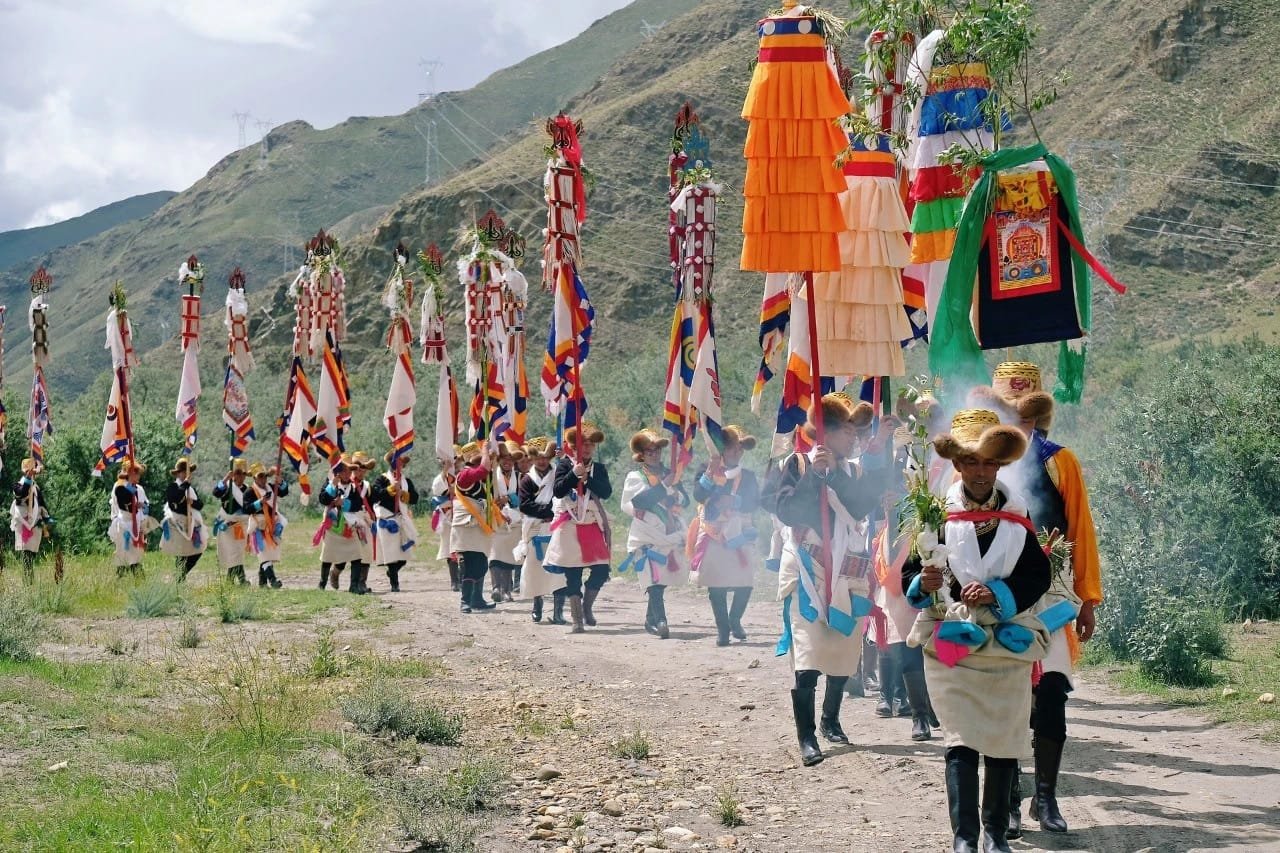Introduction to Tibetan Monasteries
Tibetan monasteries, or ‘gompas,’ hold a pivotal role in the cultural and spiritual landscape of Tibetan Buddhism. These monasteries not only serve as communities for monks and nuns but also function as vital centers for the preservation and dissemination of Buddhist teachings. Historically, the origins of Tibetan monastic architecture can be traced back over a millennium, influenced by various factors including Indian Buddhist traditions, native Tibetan culture, and geographic considerations. The interaction of these elements has resulted in a distinct architectural style that embodies the spiritual ethos of Tibetan Buddhism.
The significance of Tibetan monasteries extends beyond their architectural features; they represent sanctuaries of spiritual practice and learning. Each monastery typically includes prayer halls, monasteries for the resident clergy, and spaces dedicated to meditation and study. Pilgrims and seekers from all over flock to these sites, making them hubs of cultural exchange and spiritual engagement. The unique design of Tibetan monasteries, characterized by their colorful murals, stupas, and the iconic golden roofs, reflects deep religious symbolism and an enduring commitment to Buddhist philosophy.
Moreover, these sites are instrumental in fostering community bonds and supporting educational initiatives. Monasteries often organize teachings, rituals, and community events that draw both locals and visitors, thereby reinforcing social ties and promoting a shared understanding of Buddhist principles. They also act as repositories for historical and cultural artifacts, safeguarding Tibetan Buddhist heritage in a rapidly changing world. As such, Tibetan monasteries not only serve religious functions; they are vital centers of cultural identity and continuity.
The rich history and unique architectural styles of Tibetan monasteries will be explored further in comparison with other Buddhist traditions, shedding light on the diverse expressions of Buddhist faith across various cultures.
Distinct Architectural Elements of Tibetan Monasteries
Tibetan monasteries exhibit a distinctive architectural style characterized by a unique combination of cultural symbolism, environmental adaptation, and aesthetic richness. One of the most prominent features found in these structures is the stupa, a hemispherical dome supporting a spire, which serves as a focal point for spiritual practices. The stupa symbolizes the path to enlightenment and is often adorned with intricate carvings, gold accents, and symbolic motifs that reflect the teachings of Buddhism. Its design encourages pilgrimage and meditation, attracting visitors from all around.
Another essential element is the presence of prayer wheels, which are often installed along monastery paths. These wheels, when spun, release mantras and blessings into the environment, allowing practitioners to engage in a meditative practice while on the move. The integration of these prayer wheels not only enhances the spiritual ambiance of the monasteries but also emphasizes the connection between physical space and the spiritual journey.
Moreover, the layout of Tibetan monasteries is intentionally designed to facilitate spiritual activities. Typically laid out around a central courtyard, these complexes are often adorned with expansive murals that depict significant Buddhist themes. These vibrant paintings serve not only as decorative elements but also as instructional tools for devotees. The colors used in the murals symbolize different aspects of life, spirituality, and the teachings of the Buddha. The choice of colors, primarily rich reds, yellows, and blues, provides a striking contrast against the often stark backdrop of the mountainous landscape.
The harsh climate of the Himalayan region has also significantly shaped the architectural choices of Tibetan monasteries. Stone and wood are commonly used materials, ensuring durability while providing insulation against the cold. Such environmental considerations demonstrate the ingenuity in the design, marrying functionality with spiritual ethos. Understanding these distinct architectural elements is crucial for appreciating the cultural heritage embodied in Tibetan monasteries.
Comparative Analysis with Other Buddhist Traditions
Tibetan monasteries possess architectural features that distinguish them from their counterparts in other Buddhist traditions, such as Zen, Theravada, and Mahayana. Each tradition’s style is deeply rooted in its unique cultural, historical, and geographical contexts, leading to notable differences in design and aesthetics. Tibetan architecture is characterized by its intricate carvings, vibrant colors, and elaborate symbols, reflecting the rich spirituality and cultural heritage of the Tibetan people.
In contrast, Zen temples, primarily found in Japan, embody a more minimalist approach. Zen architecture emphasizes simplicity and tranquility, embodying the essence of Zen philosophy. The use of natural materials like wood, coupled with a focus on creating harmonious spaces, underscores the cultural values of simplicity and intentionality. This design approach often results in structures with open spaces and unobtrusive, understated beauty, starkly different from the ornamental and vibrant structures seen in Tibetan monasteries.
Theravada Buddhism, predominant in countries such as Thailand and Sri Lanka, showcases a distinctive architectural style that is less ornate than Tibetan designs. Theravada temples typically feature straightforward façades and less emphasis on elaborate decoration, aligning with the tradition’s focus on the original teachings of the Buddha. The architecture often includes large stupas and monastic complexes that serve functional purposes aligned with the lifestyle of monks and laypeople, showcasing a practical approach to religious spaces.
Mahayana traditions present a blend of influences, often resulting in grand temple complexes that reflect regional adaptations and innovations. Although they share some similarities with Tibetan structures, particularly in the use of deities and mandalas, they do not usually exhibit the same level of intricate craftsmanship. The differences across these traditions highlight the diversity of Buddhist architecture and emphasize how local cultures profoundly impact religious expression.
Cultural and Spiritual Significance of Architectural Styles
The architectural styles of Tibetan monasteries are not merely aesthetic choices; they are deeply intertwined with the cultural and spiritual fabric of Tibetan society. Each design element, from the intricate carvings to the layout of the sacred spaces, serves a significant purpose in enhancing spiritual practice and community life. The structures are strategically oriented and constructed to facilitate spiritual harmony, provide spaces for meditation, and accommodate communal gatherings, essential for maintaining the religious practices of both monks and laypeople.
Monasteries function as vital centers of Tibetan culture, reflecting the deep-rooted beliefs and traditions of the Tibetan people. The grandeur of the stupas and the symbolic representation found across the buildings exemplify the Tibetan Buddhist worldview, which is integral to worship and meditation practices. For instance, the use of specific colors and motifs is not random; each has a purpose, often symbolizing various aspects of Buddhist teachings and the enlightened path. This method of eliminating distractions and focusing attentively on the details fosters an environment conducive to meditation, essential for both monks and the laity alike.
Furthermore, the architectural choices are critical for preserving Tibetan culture amid ongoing political and environmental challenges. With the increasing pressures on Tibetan heritage, these monasteries stand as resilient symbols of identity. They provide a sense of continuity and belonging for the community while acting as repositories of traditional knowledge and practices. The communal aspect of monasteries encourages collective identity, as they serve as gathering places for rituals, festivals, and teachings, reinforcing social bonds and passing down cultural heritage to future generations. The unique architectural styles, therefore, play a significant role in sustaining the spiritual and cultural vitality of the Tibetan people.





